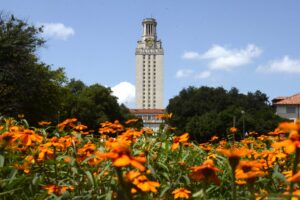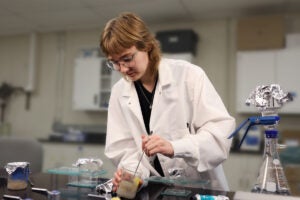They arrived on campus from New York City’s Metropolitan Museum of Art last month on flatbed trucks and tractor trailers: several towering giants of steel, iron and metal; a triad of tall, stately whip-thin spires; two carved, organic pieces, full of motion in black walnut and cherry wood. Seventeen sculptures (with 11 more arriving in January 2009) by some of the greatest artists of the mid-to-late 20th century were brought to campus through a new public art program called Landmarks at The University of Texas at Austin.
Before Tony Smith’s “Amaryllis” (1965) sprung up in the College of Fine Arts complex, it had been exhibited on the rooftop of the Met. The Donald Lipski sculpture, “The West,” now outside the Computation Center, was once exhibited at the White House during the Clinton administration.
“For the first time in its history, The University of Texas at Austin has adopted a comprehensive policy with ongoing support for public art acquisitions,” says Landmarks Director Andrée Bober. “This is the university at its best, thinking big about what it can accomplish and being decisive about shaping its future. The Met loan was key because it provides an art historical framework from which we can build our own cohesive collection with a clear, curatorial vision.”
The Met sculptures installed last August and those arriving this January are dated as early as 1948 and as late as 2000. Works by such artists as Louise Bourgeois, Hans Hokanson, Raoul Hague, Anthony Caro, Deborah Butterfield and Seymour Lipton are part of 28 total works. This group represents several artistic trends that occurred between 1948 and 2000; vestiges of Surrealism, Abstract Expressionism, Minimalism, Conceptual Art, Feminist Art, Post-minimalism and Pop can now be seen in courtyards and plazas, between buildings, in libraries and corridors, creating a sense of place and experience for people making their way around campus.
“In terms of [the sculptures’] impact and effect, they have a strength and complexity that makes you see spaces on campus in a different way,” says Art History Professor John Clarke. “The ones I’ve seen so far have enlivened the architecture enormously. What’s significant about them is they’re abstract works that yield new meanings each time you see them. That abstraction is what makes you look at them more than once. As to their quality, these works have been vetted by experts at the Met and our own art experts and scholars here at the university–these pieces are highly desirable and sought-after.”

Landmarks is the result of conversations that began in 2005. The university had been engaged with Peter Walker Partners Landscape Architects, working to reconstruct Speedway and the East Mall–an effort that conformed to the Cesar Pelli Master Plan from 1999. Walker saw the university was doing a good job following the master plan in terms of architectural character of the buildings and spatial orientation. But the effort was building-focused and had not been giving as much attention to public spaces between buildings, green spaces and gateways.Pat Clubb, vice president for employee and campus services, proposed an initiative to develop a percent-for-art policy called Art in Public Spaces. It set a goal to devote 1-2 percent of the construction cost from all major renovations and new construction projects on the campus for the acquisition of public art. After the university adopted the Art in Public Spaces policy, Landmarks was formed and housed in the College of Fine Arts with Bober at the helm developing the architecture of the program and defining its curatorial scope and mission.”The College of Fine Arts is the logical home for Landmarks as it offers the academic credibility to the selection process,” says Clubb. “Here is where the expertise exists to curate the effort in addition to overseeing the entire public art plan.”Bober approached Walker about creating a Public Art master plan for the university, and he took on the project as a pro-bono contribution to the Landmarks program. The plan is not prescriptive, but rather a set of opportunities and guidelines to consider for any public art project that might be proposed to the university. The plan offers the tools to build consistency and cohesion to public art placement on campus over time.Landmarks has three key initiatives, the first being the five-year renewable loan of 28 sculptures from the Met. These pieces are meant to provide a foundation for the university to build its own collection of acquisitions and commissions. Bober had learned that the Met lacked space for a group of sculptures that had once been exhibited and approached the museum about loaning them to the university.
“We are very pleased to make this loan to The University of Texas at Austin campus,” said Gary Tinterow, Engelhard Curator in Charge of the Metropolitan Museum’s Department of Nineteenth-Century, Modern, and Contemporary Art. “These large-scale sculptures were intended for outdoor–or very large indoor–spaces, which we do not have available in New York. With the loan of the works to Austin, they will be enjoyed by thousands of university students, staff and visitors to the university.”The Met did not charge the university for labor, mount-making, borrowing the works or insurance. The only cost incurred by the university was for transportation, installation and ongoing conservation of the pieces–a price tag commensurate with a three-month long museum exhibition.The second initiative goes back to the Art in Public Spaces policy in that it guides the purchase or commission of art for new construction or major renovation projects on the main campus. These works will be funded by an allocation from the total project cost and installed in the building’s vicinity. This percent-for-art allocation will be used to enhance the area surrounding the new construction or renovation.The third initiative is to enhance public spaces that are not associated with a specific building project and draws upon philanthropic gifts to enhance shared public spaces. Support for Landmarks goes toward funding approved acquisitions, operations, or for the ongoing care and maintenance for works of art. These auxiliary projects include gateways, medians, corridors and Waller Creek–often overlooked or underappreciated areas on campus that are now university priorities. Public art in these locations will create focal points and insure an even distribution of works across campus in accordance with the Public Art master plan.
“These pieces are not meant simply to ‘beautify’ campus, though some do,” says College of Fine Arts dean Douglas Dempster. “Some of the sculptures are aesthetically challenging and decidedly not pretty–but they’re all remarkable works. Faculty members from all different departments across campus are already taking advantage of these sculptures in their teaching. Even the controversies that some of these pieces will inevitably generate will be teaching opportunities.”Although they’re both housed in the College of Fine Arts, the Landmarks public art program is a decidedly different program from the Jack S. Blanton Museum of Art. Landmarks has a different mission, presentation and audience from the Blanton. The difference can be explained by defining the difference between art and public art.”A museum creates a very controlled environment, in which the works become a destination. You have to pay admission, you walk past a security guard, and you’re participating in a staged approach to how the experience is supposed to unfold,” says Bober, “whereas public art simply exists in the environment. People who are walking from one place to another may have no intention of engaging with a work of art, but because it happens to be in the landscape, they happen to see it, and it becomes part of their experience in unexpected and surprising ways.”Because this particular kind of art resides in the public domain, there’s the question as to who gets to choose the art the public will see. Landmarks has its own advisory committee composed of student, faculty, staff representatives and community stakeholders. The core committee is a team of art specialists: Sarah Canright, John Clarke and Amanda Douberly from the Department of Art and Art History, Mirka Benes from Landscape Architecture, and Blanton curator Annette Carlozzi. Representatives from the departments, divisions, or offices closest to a specific work, as well as building project managers and architects, may also be asked to join the committee on a project-by-project basis.

The approval process for any proposal for the installation of a piece of public art on campus begins with the Subcommittee for the Review of Artwork (SRA), led by Ken Hale, chair of SRA and associate dean for the College of Fine Arts. The SRA formed to respond to requests from the public and the university community for works of art on campus. The SRA makes recommendations to the Faculty Building Advisory Committee, which then go on for approval by Employee and Campus Services before they are reviewed by the president’s Facilities and Space Council and passed on to the Board of Regents for final approval.
Landmarks is also making connections across campus. On Sept. 26, the university will be receiving a monumentally scaled work titled “Clock Knot” from artist Mark di Suvero–one of the most important artists of the 20th and 21st centuries. The dedication of his work coincides with the opening of the exhibition “Reimagining Space: The Park Place Gallery Group in 1960s New York” at the Blanton Museum of Art–an exhibition guest-curated by Art and Art History Professor Linda Henderson. Early examples of di Suvero’s work will be included in the Blanton exhibition that runs from Sept. 28 to Jan. 18, 2009.
“Clock Knot” will be installed on the northeast corner of Dean Keeton Street and Speedway, adjacent to the Cockrell School of Engineering. It’s a gargantuan work, 41 feet tall and constructed from intersecting steel beams with a circular ‘knotted’ center, suggesting a giant clock face with hands. It will be painted bright red once it’s constructed and installed. It’s a multi-ton visual manifestation made for that space as it exemplifies engineering principles of balance and force, and will likely become a landmark on campus, testimony to the transformational power of public art.





